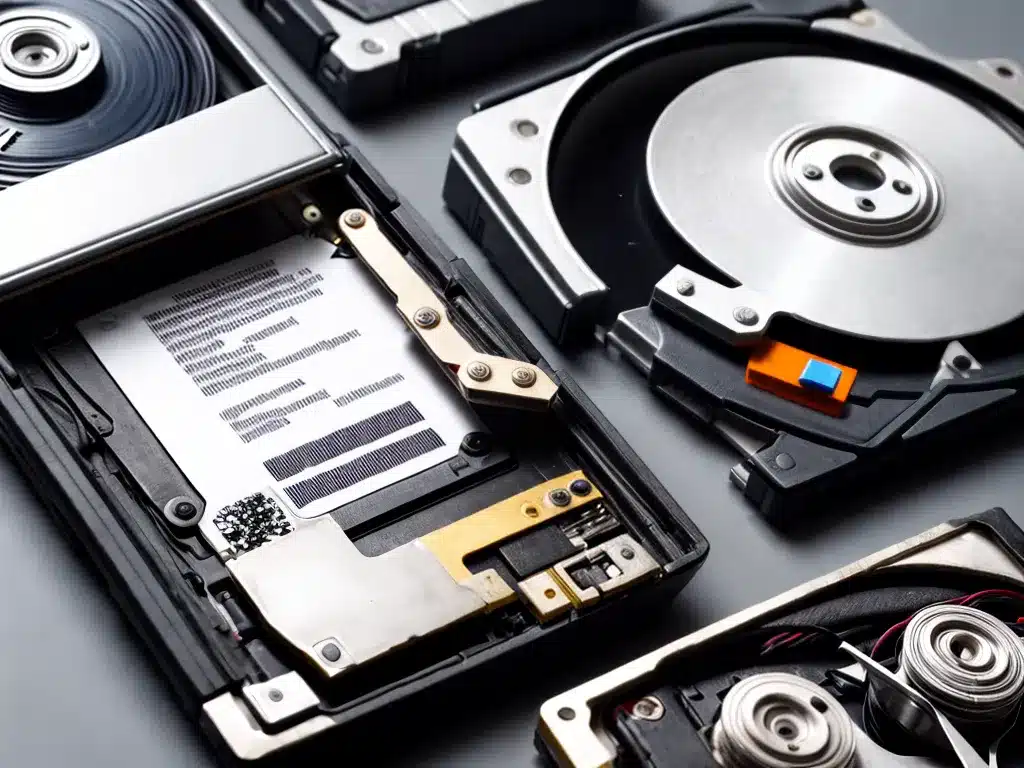
Introduction
As technology advances, older storage formats like floppy disks and Zip disks can become difficult to access. However, with some effort, it is often possible to retrieve data from these old media in 2024. In this article, I will provide an in-depth guide on methods to extract files from vintage floppy disks and Zip disks.
Accessing Data on Floppy Disks
Floppy disks were a common method of data storage from the 1970s through the 1990s. The two most popular floppy disk formats were:
-
3.5″ diskettes – These “stiffy” disks could hold up to 1.44 MB of data. They were used with computers like the original iMac.
-
5.25″ diskettes – These larger “floppy” disks could hold up to 1.2 MB of data. They were used with computers like the Apple II.
To access data on a floppy disk in 2024, you will need:
-
A floppy disk drive – These can be purchased from vintage computer stores or online retailers. USB floppy drives that connect to modern computers are the easiest option.
-
Floppy disk controller software – Vintage OS emulators like Windows 98 or programs like FC5025 can allow modern OSes to interface with floppy drives.
-
Data recovery software – Programs like DiskDrill can read damaged floppy disks and recover lost files.
To extract the data:
-
Carefully insert the floppy disk into the disk drive. Use a pen or specialized tab cover tool to secure any open shutter doors.
-
Use the disk controller software to initialize the floppy drive. Assign a drive letter like A: or B: to the floppy drive.
-
Browse to the newly assigned drive letter and explore the contents of the floppy disk. Copy any needed files off of the disk.
-
If any files are corrupted or the disk is unreadable, use data recovery software to attempt to resuscitate lost files.
-
Always keep floppy disks stored upright and in a cool environment away from magnets to prevent further data loss.
Accessing Data on Zip Disks
Zip disks were a popular high-capacity removable storage format through the late 90s and early 2000s. The most common Zip disks could hold up to 750 MB of data. To access Zip disk data in 2024, you’ll need:
-
A Zip drive – USB-powered Zip drives can usually still interface with modern computers. Original parallel port Zip drives will require a legacy connection.
-
Zip disk software – Vintage OS emulators or programs like ZipDrive Freedom can allow you to mount Zip disks on a modern computer.
-
Data recovery software – To recover corrupted or deleted files from a Zip disk.
To extract files from a Zip disk:
-
Carefully insert the Zip disk into the Zip drive. Make sure the metal shutter door is secured.
-
Use the Zip disk software to mount the disk and assign it a drive letter.
-
Open the mounted drive and browse the files, copying anything needed off the disk.
-
If the disk is damaged, use data recovery software to try to rescue files. Scans and recovery can take hours for large Zip disks.
-
Always store Zip disks at room temperature away from moisture and magnetic fields to prevent data loss.
Challenges You May Encounter
Retrieving data from older disks comes with some potential challenges:
-
Hardware availability – Floppy and Zip drives are hard to find. Used devices may also be prone to failure.
-
Software compatibility – Vintage OS emulators may not work perfectly. Disk controller software can be tricky to configure.
-
Disk degradation – Floppies and Zips degrade over time. Data layers can flake or magnetization can weaken, making data recovery difficult.
-
Fragmented files – File fragments scattered across a damaged disk are harder to recover.
With some patience and the right tools, most vintage media can still give up its data. But degradation and obsolete technology limit success rate. Seek help from a data recovery service if DIY efforts are unsuccessful.
Alternative Data Recovery Options
If you are unable to access data on a floppy or Zip disk yourself, there are companies that specialize in extracting data from vintage media. Some things to keep in mind when seeking professional recovery:
-
Cost – Services often charge $100s per disk. Get a quote before sending media.
-
Success rate – Reputable firms have dust-free rooms and advanced tools, but no guarantee of recovery.
-
Non-destructive – Ensure the company attempts non-destructive disk repair first before invasive methods.
-
Turnaround time – Data recovery can take days or weeks depending on complexity.
As a last resort, seeking professional assistance can potentially recover vital files from decades-old media. But the process is expensive and success is variable.
Final Thoughts
Salvaging data from floppy disks and Zip disks gets increasingly difficult as these technologies fade further into history. But with some dedicated legacy hardware, specialized software, and technical diligence, resurrecting data from this media in 2024 is still often possible. Just be prepared for potential challenges and some trial and error. In the end, recovering those vital files makes the effort worthwhile.












